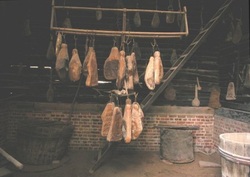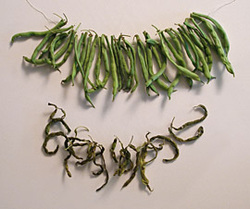Eating All Winter Long
Today, most of the food Americans wish to eat can be found all year long at any supermarket or restaurant—even vegetables and fruits that are out of season. Thanks to refrigeration, chemicals and easy importing of fresh foods, our diet today is one of convenience, availability and choice. But the food preservation methods so common today weren't available in the late-1700s, so much more of the daily fare was eaten fresh, especially by the non-wealthy. "Anyone who wanted chicken for dinner got the bird early in morning, killed it, cleaned it—which included plucking—and cooked it. Colonists ate the leftovers at supper and breakfast before they could spoil" (Crews, 2004, para. 7). Fruit and vegetables were eaten when harvested in season.
Meats

Interior of a smoke house at Mt. Vernon, Virginia.
The early American settlers needed ways to preserve all sorts of foods, but especially meats, throughout the winter. Pork, being plentiful and easy to raise, became a staple of the Colonial diet. Soaking meat in brine (salt or vinegar water) was one step in the preservation process (Kalman & Brown, 2002, p. 15). "Long, bitter, blustery winters kept menus anchored to the pork barrel in the cellar of the house, where red-streaked creamy slabs of side meat had been laid down in brine thick enough to let the pork pieces float when the heavy hewn-oak cover was lifted" (Jones, 1981, p. 17).
Pork (and other meats) could also be salted (by rubbing the meat vigorously with salt by hand), then cured in a separate building called a smokehouse. "Smoke from different types of wood flavored the meat as well as curing it. The cook hung pieces of meat and fish from the rafters and then built a fire in a pit below the smoke house. The smoke rose and filled the small building, since there was no chimney through which it could escape" (Kalman & Brown, 2002, p. 12).
Pork (and other meats) could also be salted (by rubbing the meat vigorously with salt by hand), then cured in a separate building called a smokehouse. "Smoke from different types of wood flavored the meat as well as curing it. The cook hung pieces of meat and fish from the rafters and then built a fire in a pit below the smoke house. The smoke rose and filled the small building, since there was no chimney through which it could escape" (Kalman & Brown, 2002, p. 12).
Fruits and Vegetables

Although the Colonists built their meals around the available meats, they were also invested in preserving fruits and vegetables to enjoy throughout the winter. Apples were "peeled, cored, and quartered and then spread upon a platform of boards in the yard" (Moss & Hoffman, 2001, p. 87). The apples were then left to dry, ideally once the weather has turned cold. Peaches were dried in a similar fashion. Some fruits and vegetables were strung up and left to dry outside, or inside near the fire (Ichord, 1998, p. 15).
Colonial settlers also "cooked some fruits with sugar to make preserves such as jams, jellies and marmalades. They dried or pickled other fruits and vegetables" (Kalman & Brown, 2002, p. 14) including peas, beans, okra, radishes and cucumbers. Vegetables that had been dried were sometimes tossed in soups, or soaked in warm water and used in other dishes.
Colonial settlers also "cooked some fruits with sugar to make preserves such as jams, jellies and marmalades. They dried or pickled other fruits and vegetables" (Kalman & Brown, 2002, p. 14) including peas, beans, okra, radishes and cucumbers. Vegetables that had been dried were sometimes tossed in soups, or soaked in warm water and used in other dishes.
Title photo: Various herbs drying at Old Salem in Winston-Salem, NC. Taken in March 2012 by Brooks Jones.
